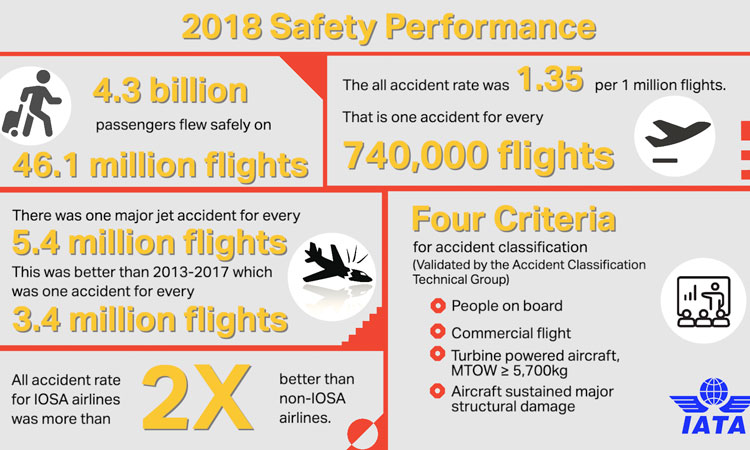IATA releases 2018 safety performance data for commercial airlines
- Like
- Digg
- Del
- Tumblr
- VKontakte
- Buffer
- Love This
- Odnoklassniki
- Meneame
- Blogger
- Amazon
- Yahoo Mail
- Gmail
- AOL
- Newsvine
- HackerNews
- Evernote
- MySpace
- Mail.ru
- Viadeo
- Line
- Comments
- Yummly
- SMS
- Viber
- Telegram
- Subscribe
- Skype
- Facebook Messenger
- Kakao
- LiveJournal
- Yammer
- Edgar
- Fintel
- Mix
- Instapaper
- Copy Link
Posted: 22 February 2019 | International Airport Review | No comments yet
The data from IATA reveals that commercial airline safety has kept on its upward trajectory in the long-term, but shows that there has been a slight increase in accidents from 2017.


IATA has released data for the 2018 safety performance of the commercial airline industry showing continuing safety improvements over the long term, but an increase in accidents compared to 2017.
The all accident rate (measured in accidents per one million flights) was 1.35, which was the equivalent of one accident for every 740,000 flights. This was an improvement over the all accident rate of 1.79 for the previous five-year period (2013-2017), but a decline compared to 2017’s record performance of 1.11.
The 2018 rate for major jet accidents (measured in jet hull losses per one million flights) was 0.19, which was the equivalent of one major accident for every 5.4 million flights. This was an improvement over the rate for the previous five-year period (2013-2017) of 0.29 but not as good as the rate of 0.12 in 2017.
There were 11 fatal accidents with 523 fatalities among passengers and crew. This compares with an average of 8.8 fatal accidents and approximately 234 fatalities per year in the previous five-year period (2013-2017). In 2017, the industry experienced six fatal accidents with 19 fatalities, which was a record low. One accident in 2017 also resulted in the deaths of 35 people on the ground.
Alexandre de Juniac, IATA’s Director General and CEO, said: “Last year some 4.3 billion passengers flew safely on 46.1 million flights. 2018 was not the extraordinary year that 2017 was. However, flying is safe, and the data tells us that it is getting safer. For example, if safety in 2018 had remained at the same level as 2013, there would have been 109 accidents instead of 62; and there would have been 18 fatal accidents, instead of the 11 that actually occurred.”
He continued: “Flying continues to be the safest form of long distance travel the world has ever known. Based on the data, on average, a passenger could take a flight every day for 241 years before experiencing an accident with one fatality on board. We remain committed to the goal of having every flight takeoff and land safely.”
Progress in Africa
For a third consecutive year, airlines in sub-Saharan Africa experienced zero jet hull losses and zero fatalities in jet operations. The all accident rate was 2.71, a significant improvement over the rate of 6.80 for the previous five years. Africa was the only region to see a decline in the all-accident rate compared to 2017. However, the region experienced two fatal turboprop accidents, neither of which involved a scheduled passenger flight.
de Juniac stated: “We continue to progress in the region toward world-class levels of safety. But, despite improvement there is still a gap to cover in the safety performance of the continent’s turboprop fleet. Global standards such as the IATA Operational Safety Audit (IOSA) are making a difference. Counting all accidents, the performance of African airlines on the IOSA registry was more than twice as good as non-IOSA airlines in the region.
“In parallel, African governments must accelerate the implementation of ICAO’s safety-related standards and recommended practices (SARPS). As of year-end 2017, only 26 African countries had at least 60 per cent SARPS implementation. They also should incorporate IOSA into their safety oversight systems.”
Data-driven approach to identifying current and emerging risks
IATA’s Global Aviation Data Management (GADM) programme is the world’s most diverse aviation data exchange programme. Data captured in GADM databases comprises accident and incident reports, ground damage occurrences and flight data from more than 470 different industry participants. “Through GADM, we are using information from the more than 100,000 flights that operate safely every day to identify and address operational issues before they can become potential risks,” said de Juniac.
The Flight Data Exchange (FDX) platform contains de-identified information from four million flights. Additionally, with the imminent introduction of Incident Data Exchange (IDX), participants will be provided with enhanced data analytics and benchmarking capabilities with aggregated de-identified global safety data. IATA has also been working with more than 100 aviation safety professionals on the IATA Safety Incident Taxonomy (ISIT). The ISIT will provide the ability to better capture global risk at a more granular level.
One well-known hazard is in-flight turbulence. As passenger and cabin crew injuries related to in-flight turbulence climb, IATA sees a need to address this increasing safety risk. In response, IATA has launched Turbulence Aware, a global platform for sharing automated turbulence reports in real time. Operational trials with a number of airlines are being conducted this year, with full launch planned for 2020.
Related topics
Related organisations
International Air Transport Association (IATA), International Civil Aviation Organization (ICAO)

















